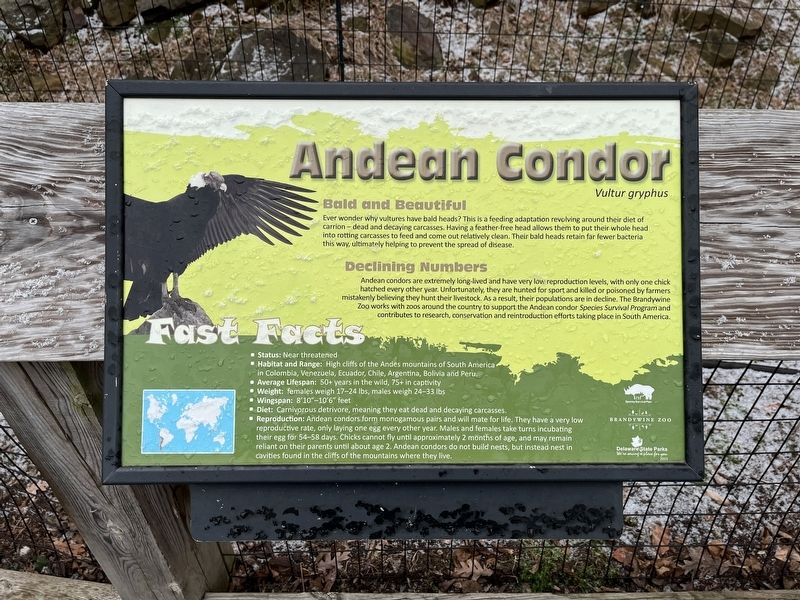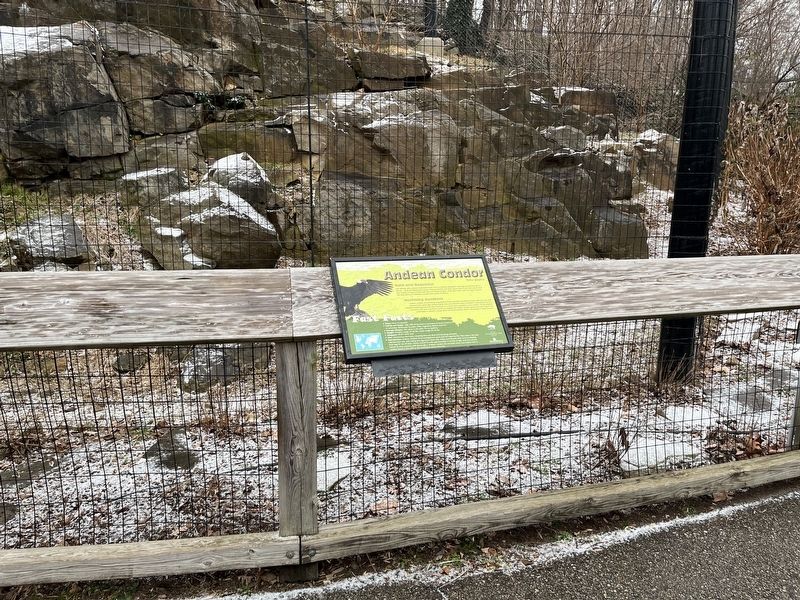Brandywine Park in Wilmington in New Castle County, Delaware — The American Northeast (Mid-Atlantic)
Andean Condor
Vultur gryphus
Bald and Beautiful
Ever wonder why vultures have bald heads? This is a feeding adaptation revolving around their diet of carrion — dead and decaying carcasses. Having a feather-free head allows them to put their whole head into rotting carcasses to feed and come out relatively clean. Their bald heads retain far fewer bacteria this way, ultimately helping to prevent the spread of disease.
Declining Numbers
Andean condors are extremely long-lived and have very low reproduction levels, with only one chick hatched every other year. Unfortunately, they are hunted for sport and killed or poisoned by farmers mistakenly believing they hunt their livestock. As a result, their populations are in decline. The Brandywine Zoo works with zoos around the country to support the Andean condor Species Survival Program and contributes to research, conservation and reintroduction efforts taking place in South America.
Fast Facts
• Status:Near threatened.
• Habitat and Range: High cliffs of the Andes mountains of South America in Colombia, Venezuela, Ecuador, Chile, Argentina, Bolivia and Peru.
• Average Lifespan: 50+ years in the wild, 75+ in captivity.
• Weight: females weigh 17-24 lbs, males weigh 24-33 lbs.
• Wingspan: 8'10"-10'6" feet
• Diet: Carnivorous detrivore, meaning they eat dead and decaying carcasses.
• Reproduction: Andean condors form monogamous pairs and will mate for life. They have a very low reproductive rate, only laying one egg every other year. Males and females take turns incubating their eggs for 54-58 days. Chicks cannot fly until approximately 2 months of age, and may remain reliant on their parents until about age 2. Andean condors do not build nests, but instead nest in cavities found in the cliffs of the mountains where they live.
Erected 2015 by Brandywine Zoo; Delaware State Parks.
Topics and series. This historical marker is listed in these topic lists: Animals • Environment. In addition, it is included in the Delaware State Parks series list.
Location. This marker has been replaced by another marker nearby. It was located near 39° 45.337′ N, 75° 32.962′ W. Marker was in Wilmington, Delaware, in New Castle County. It was in Brandywine Park. Marker could be reached from North Park Drive, 0.1 miles east of North Van Buren Street, on the right when traveling west. Touch for map. Marker was at or near this postal address: 200 N Park Dr, Wilmington DE 19802, United States of America. Touch for directions.
Other nearby markers. At least 8 other markers are within walking
Related marker. Click here for another marker that is related to this marker. This marker has been replaced with the linked marker.
Additional commentary.
1. About the marker
This marker qualifies for the Database because it shares how human interaction has affected the species in its environment.
— Submitted January 28, 2022, by Devry Becker Jones of Washington, District of Columbia.
Credits. This page was last revised on February 11, 2023. It was originally submitted on January 28, 2022, by Devry Becker Jones of Washington, District of Columbia. This page has been viewed 96 times since then and 10 times this year. Photos: 1, 2. submitted on January 28, 2022, by Devry Becker Jones of Washington, District of Columbia.

